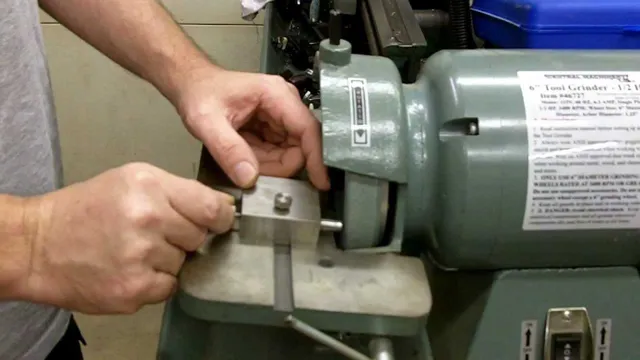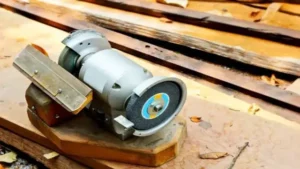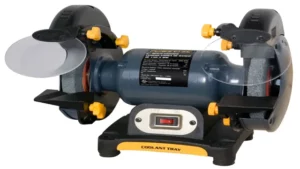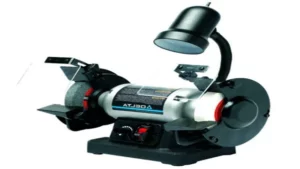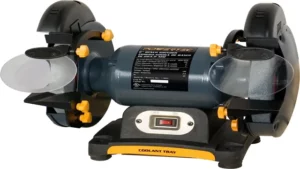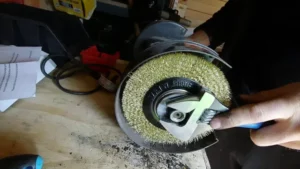If you own a bench grinder, you know how useful it is to have a tool like this at your disposal for sharpening and shaping metal tools or parts. However, over time, the grinding wheel will become worn out and will need to be dressed appropriately to restore its optimal performance. So, how do you dress a grinding wheel on a bench grinder? In this blog post, we will provide you with all the information you need to get your grinder wheel back in shape for your next DIY project or job.
We will cover the tools you need, the steps you should follow, and some tips to make the whole process a bit easier. So, let’s dive in!
What is a Grinding Wheel?
A grinding wheel is a cylinder made up of abrasive particles that are bonded together to form a strong and durable tool for grinding and shaping metal and other materials. It is commonly used in bench grinders, as it provides a quick and efficient way of sharpening and smoothing blades, tools, and other metal objects. However, over time the grinding wheel can become worn down or clogged with debris, which can negatively impact its performance and effectiveness.
To address this issue, it is important to dress the grinding wheel on a regular basis. Dressing a grinding wheel involves removing any debris or excess material from the surface of the wheel, which allows for smoother and more accurate grinding. To dress a grinding wheel on a bench grinder, one can use a diamond dresser or other specialized tool to gently rub the dresser against the surface of the wheel in a back-and-forth motion.
This process helps to restore the wheel’s shape and sharpness, ensuring that it operates at its full potential.
Definition and Types
A grinding wheel is an industrial tool that is used for various purposes such as cutting, shaping, and smoothing hard materials like metal, stone, and concrete. It consists of abrasive particles bonded together on a rotating wheel which cuts and removes material from the workpiece. Grinding wheels come in different types, each designed for specific tasks.
The straight wheel is the most common type and is used for cylindrical grinding. A recessed wheel is designed for internal grinding, while a cup wheel is ideal for tool sharpening, surface grinding, and cylindrical grinding. The dish wheel is suitable for sharpening tools and grinding threads, while a segmented wheel is used for high-speed machining and cutting hard materials.
The type of grinding wheel used depends on the material being grinded and the desired finish. Choosing the right wheel ensures the best results and reduces machine wear and tear.
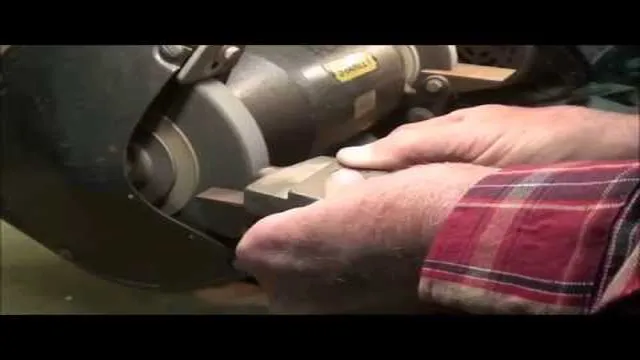
Wheel Grit and Materials
A grinding wheel is a circular tool with abrasive grains bonded together, used for grinding and sharpening various materials. The abrasive grains are usually made of aluminum oxide, silicon carbide, diamond, or cubic boron nitride. The bonding material can be resin, vitrified, metal, or electroplated.
Different types of grinding wheel materials and grits are used for different applications. Coarse grit sizes are used for fast material removal, and fine grits are used for smooth finishing. The hardness of the wheel also plays a critical role in its performance.
Softer wheels wear out more quickly, but are more forgiving, while harder wheels tend to last longer but can be more prone to cracking. It’s important to choose the right grinding wheel grit and material based on the job at hand to ensure optimal results and to preserve the life of your grinding wheel.
Why Dress a Grinding Wheel?
If you want to maintain the efficiency and longevity of your grinding wheel on a bench grinder, it’s vital to dress it properly. Dressing a grinding wheel frequently means truing it up, removing debris, smoothing its surface, and sharpening its profile. These steps help eliminate irregularities on the wheel’s surface caused by constant use.
Neglecting to dress the wheel can result in decreased performance, inaccurate grinding, and possible injury. Using a diamond dressing tool, you can easily dress the wheel in just a few steps. Make sure to clean and inspect the wheel before dressing it, as well as adjusting the tool rest to the appropriate angle for grinding.
Proper dressing of the grinding wheel on a bench grinder is a crucial step to ensure safe, efficient, and consistent grinding operations.
Maintaining Wheel Performance
Grinding wheels are an essential part of any grinding activity, be it in a manufacturing unit or a DIY workshop. However, they don’t last forever and tend to wear out over time due to constant use. This is where dressing the grinding wheel comes into play.
By dressing the wheel, you essentially remove the worn-out abrasive material and expose fresh abrasive particles, thereby maintaining wheel performance. It also helps to maintain the shape and geometry of the grinding wheel, which ensures precision and accuracy while grinding. So, the next time you notice your grinding wheel losing its sharpness or shape, remember to dress it up for optimal performance.
It’s simple and easy to do, and your grinding wheel will thank you for it!
Reducing Wheel Burn and Vibration
Grinding wheels are essential tools in many industries and can help you achieve the desired finish on your workpiece. However, they are prone to wear and tear, resulting in wheel burn and vibrations that can affect the quality of your workpiece and increase tooling costs. This is where the importance of a grinding wheel dresser comes in.
By regularly dressing your grinding wheel, you can reduce wheel burn and vibration and improve your workpiece quality. The dressing process involves removing dulled abrasive grains and creating a new sharp cutting surface on the wheel. This helps reduce heat build-up during use, resulting in a cooler grinding process and improved surface finish.
So, if you want to achieve high-quality finishes and prolong the life of your grinding wheel, consider investing in a grinding wheel dresser.
Removing Glazing and Residue
When it comes to grinding wheels, dressing them is an essential step to ensure optimal performance. One of the reasons why you might need to dress a grinding wheel is to remove glazing and residue buildup. Glazing is a common occurrence when the abrasive particles on the wheel become dull and clogged.
As a result, the wheel loses its cutting ability, leading to ineffective grinding. Residue buildup, on the other hand, can come from materials being ground, leading to a decrease in cutting ability and a reduction in the life of the wheel. Dressing the wheel not only removes the glazing and residue buildup but also exposes fresh abrasive particles, thus restoring the wheel’s cutting ability.
Failure to dress the wheel can lead to increased stress on the wheel, resulting in cracks and even wheel failure. Therefore, dressing a grinding wheel is a crucial step that should never be overlooked, ensuring efficiency, longevity, and ultimately, safety.
How to Dress a Grinding Wheel
If you own a bench grinder, it’s essential to know how to dress a grinding wheel properly. Grinding wheels can become clogged with metal debris or lose their shape over time, making them less effective for sharpening or grinding. To dress a grinding wheel, you’ll need a wheel dresser, which is a special tool with a diamond-coated head that smooths and reshapes the wheel.
Start by turning off the bench grinder and removing any debris or metal shavings from the wheel. Then, position the dresser at a 90-degree angle to the wheel and turn on the grinder. Move the dresser back and forth across the surface of the wheel, applying light pressure.
Once the wheel has been sufficiently dressed, turn off the grinder and clean the wheel to remove any remaining debris. By learning how to dress a grinding wheel, you can ensure that your bench grinder is always in top condition and ready to tackle any task.
Step 1: Turn Off and Secure Grinder
When it comes to dressing a grinding wheel, safety should always be the top priority. Step one is to turn off and secure the grinder to prevent any accidents from occurring. Once this is done, it’s time to start dressing the wheel.
This involves removing any build-up that may have accumulated on the surface of the wheel to ensure that it performs optimally. To do this, you’ll need a dressing tool, which can be a diamond dresser or a dressing stick. Simply run the tool along the wheel’s surface to remove debris, and be sure to follow the wheel’s direction of rotation.
It’s important to dress the wheel regularly, as doing so can extend its life and improve its grinding performance. By taking the time to dress your grinding wheel properly, you can ensure that it operates safely and efficiently, so you can get the best results possible.
Step 2: Select Dressing Tool
When it comes to dressing a grinding wheel, selecting the right dressing tool is crucial. There are a variety of dressing tools available, including diamond dressers, single point dressers, and multi-point dressers. The type of dressing tool you choose will depend on the type of grinding wheel you are using, as well as the type of material you will be grinding.
Diamond dressers are typically used for harder materials, while single point dressers are best suited for softer materials. Multi-point dressers can be used for both types of materials. It’s important to choose a dressing tool that is appropriate for your specific needs to ensure that your grinding wheel performs optimally.
So, take the time to research and choose the right tool for the job, and you’ll be on your way to perfectly dressed grinding wheels every time.
Step 3: Adjust Tool and Grinder
If you want to achieve the best results for your grinding wheel, it’s important to understand how to dress it properly. This process involves adjusting both the grinder and the tool so that they work together in the most effective way. One of the most crucial steps is to ensure that the wheel is dressed evenly.
This means checking for any areas of uneven or excessive wear and making adjustments as necessary. You can do this by using a dressing tool, which can be either a stationary tool or a rotating one. By using the tool to remove any built up debris and smooth out any rough edges, you’ll be able to get the best possible performance from your grinding wheel.
With just a bit of practice, you’ll be able to master the art of dressing a grinding wheel and achieve the best possible results. So go ahead and give it a try – your grinding wheel will thank you!
Step 4: Apply Dressing Tool to Wheel
Now that you’ve adjusted the tool rest, put on your safety gear, and you have the dressing tool in hand, it’s time to apply it to the wheel. A dressing tool is a handheld device that looks like a stick with a diamond tip. Its job is to remove abrasive particles and other debris clinging to the grinding wheel, which helps to keep the wheel sharp and clean.
First, you need to turn on your grinder and start it at a low speed setting. Then, bring the dressing tool to the wheel and hold it at a slight angle. Press the diamond tip gently against the wheel’s surface and move it across the wheel while maintaining light pressure.
Afterward, turn off the grinder and inspect the wheel to ensure it’s free of debris. Remember, the keyword for this post is “grinding wheel dressing.” By properly dressing your wheel, you can extend its life, prevent accidents, and get better results in your grinding operations.
Step 5: Repeat as Needed
When you’ve completed all the steps for dressing a grinding wheel, you’ll want to test it out to see how well it performs. Start by running the wheel for a few minutes without any load to let it settle in. Make sure to stand clear and wear eye protection in case the wheel is unbalanced.
Next, turn off the machine and inspect the wheel for any cracks or damage. If everything looks good, you’re ready to begin using the newly dressed wheel. However, if you notice any problems, repeat the dressing process until you achieve the desired results.
Remember to always take proper safety precautions when using any type of grinding wheel. By following these steps and repeating as needed, you’ll be able to dress your grinding wheel efficiently and safely while achieving the best possible results.
Precautions and Tips
Grinding wheels are essential tools for any DIY enthusiast or professional. Dressing a grinding wheel on a bench grinder is an important maintenance task that ensures the wheel remains in top condition and functions smoothly. Before you start dressing a grinding wheel, it is crucial to take some precautions to avoid any injuries.
Firstly, make sure the grinder is unplugged before you begin. Secondly, wear safety gear like gloves, goggles, and a respirator to protect yourself from flying debris and dust. Once you have taken all the necessary precautions, you can proceed with the dressing process.
The best approach is to use a diamond dresser that is specifically designed for this task. Place the dresser horizontally on the grinding wheel and apply light pressure to create a new surface on the wheel. It is important to work evenly and avoid creating any cracks or uneven rough patches.
After completing the process, inspect the wheel carefully to ensure that it has an even surface. With these tips, you can keep your grinding wheel in excellent condition and achieve the best results from your bench grinder.
Safety Gear and Procedures
When it comes to working with heavy machinery and power tools, safety should always be the number one priority. Wearing appropriate safety gear, such as eye and ear protection, hard hats, and steel-toed boots, can significantly reduce the risk of injury on the job. Additionally, it’s essential to be aware of your surroundings and understand the proper procedures for handling the equipment.
Taking the time to read and fully comprehend the operator’s manual for any machinery you will be using is critical to ensure safe operation. Whether you’re a seasoned professional or just starting your career, always remember that one mistake can have severe consequences. So stay alert, stay focused, and always take safety precautions seriously.
By doing so, you can help ensure that you and your co-workers make it home safely at the end of each day. Stay safe, and happy working!
Maintaining Dressing Tool and Wheel
Maintaining your dressing tool and wheel is a crucial part of keeping your grinding operations running smoothly. There are a few precautions and tips to keep in mind to ensure you get the most of your tools and wheels. First, make sure to wear the necessary protective gear when dressing the tool or wheel to avoid injury.
Additionally, proper storage and handling of the wheel can extend its lifespan, which means checking for any cracks or damage to the wheel before use is important. You should also ensure that the dressing tool is compatible with the wheel to avoid any potential for damage or deviation in your grinding process. Remember that the lifespan of your wheel and tool will depend on how frequently you use them, the materials you’re grinding, and your maintenance routine.
It’s essential to adhere to the manufacturer’s guidelines, store your tools and wheels safely, and replace them as necessary to ensure consistent and efficient grinding. By taking these precautions, your dressing tool and wheel will last longer and perform better, resulting in a better grinding experience.
Working with Different Materials
When working with different materials, it’s important to take certain precautions to ensure your safety and the quality of your results. First, always wear proper protective gear like gloves, goggles, and masks to avoid inhalation of harmful particles or exposure to toxic substances. Additionally, make sure to have the right tools for each material and job, as using the wrong ones can damage either the material or the tool itself.
Another crucial factor to consider is temperature and humidity. Some materials require specific environmental conditions to perform optimally, and failing to account for this could lead to subpar results. For instance, wood may warp or split if exposed to sudden changes in temperature or humidity.
Lastly, it’s always a good idea to do a test piece before committing to a whole project, especially when working with new materials. This will help you familiarize yourself with any quirks or challenges and adjust your techniques as necessary.
Conclusion
In conclusion, dressing a grinding wheel on a bench grinder is like giving it a haircut. You want to remove the bad ends, shape it to perfection, and give it an edge that can cut through anything. With the right tools and technique, your grinding wheel will be sharper than a barber’s razor and ready to tackle any job.
So, don’t let a dull grinding wheel slow you down – get in there, give it a little TLC, and watch it work wonders!”
FAQs
What safety precautions should be taken before dressing a grinding wheel on a bench grinder?
Safety glasses should be worn, sparks should be directed away from the body, and the grinder should be turned off and unplugged before dressing the wheel.
How often should a grinding wheel be dressed?
Grinding wheels should be dressed regularly, approximately every 40-60 hours of use, to maintain their shape and effectiveness.
What is the purpose of dressing a grinding wheel on a bench grinder?
Dressing a grinding wheel helps to remove dull, flat spots on the wheel’s surface and restore its original round shape, creating a sharper, more effective abrasive surface that is better suited for precision grinding work.
What tools are needed for dressing a grinding wheel on a bench grinder?
To dress a grinding wheel on a bench grinder, you will typically need a dresser tool, which can be in the form of a handheld diamond dresser or a stationary star-wheel dresser.
What is the correct technique for dressing a grinding wheel on a bench grinder?
The correct technique for dressing a grinding wheel on a bench grinder involves positioning the dresser tool against the spinning wheel at a slight angle, applying enough pressure to remove any dull or flat spots, and making multiple passes until the wheel is evenly dressed.
How can you tell when it’s time to dress a grinding wheel on a bench grinder?
Signs that a grinding wheel may need to be dressed include a decrease in grinding speed or effectiveness, visible flat spots or cracks on the wheel surface, or an uneven or chattering grinding action.
Can any type of grinding wheel be dressed on a bench grinder?
Not all types of grinding wheels can be dressed on a bench grinder. Some materials, such as diamond and CBN wheels, require specialized dressing methods and tools, which may not be compatible with a standard bench grinder.
